Fruit trees are a central element of any garden plot. They not only help to ride the territory, but also bring a good crop of healthy and delicious fruits.
The most popular fruit tree in the garden is an apple tree, because it is simply impossible to imagine the autumn colorful weather without a juicy and ripe apple. However, the full-fledged apple tree takes a lot of space on the plot, not allowing nothing to plant. That is why in recent years, breeders are withdrawn new types of apple trees - colon-shaped, which are optimally suitable for small gardens. Colon's apple tree is a very compact tree that grows vertically up and brings a large crop of large and tasty fruits.
In this article we will consider the features, descriptions and advantages of colonum apple trees, as well as we describe the most popular varieties of this type of fruit tree. We will tell about the main nuances of agrotechnics growing a colonum apple tree on your site.
Features, description and advantages of coloniform apple
Colon's apple tree is a relatively young appearance of an apple tree, which is characterized by a significantly smaller crown. On the territory of Canada, in British Columbia in 1964, one farmer discovered on his old apple tree variety Makintosh an unusual branch that did not have lateral shoots. In addition, this thread was thickly covered with foliage and straight robbed with large apples. It became a natural mutation of the ordinary apple tree in colonum-shaped. After such a discovery, the cuttings were reproduced on the apple bodies. The result was obtaining a full-fledged colonum apple tree, the variety of which was given the name of the Vazhak.
Years later, the selection of colonum apple trees began to work around the world and the first samples were already obtained 10 years later. Since then, a huge number of varieties of colonum apple trees are derived, which are distinguished by different levels of frost resistance, height, size and flavor of fruits.
Colonial apple tree description:
- Colon's apple trees are reminded by a pyramidal poplar.
- They differ in the lack of long side shoots along the central trunk, which makes the crown only 50 cm in diameter.
- All coloniary apple trees can be divided into several varieties: dwarf, semi-caric and stronger. According to these sections, it is possible to judge the height of colon-shaped apple trees: the dwarf can grow only by an average of 1-1.5 m, half-classic reaches a height of 2-2.5 m. And the strongest most often put on the high apple trees, thanks to which they grow to 3 M and above.
- The trunk of a colonum apple tree is much thicker than the ordinary apple tree, covered with foliage and small branches with floral kidney.
- Soothes from such an apple trees are much thicker and shorter.
- The first years after landing the side shoots are very branched, so the colonum apple tree needs trimming.
- For this type of apple tree, the point of growth is important, since when it is damaged, the growth of colonum apple tree will stop.
- The flowering and fruiting of such an apple tree begins usually on the second or third year after landing. This is one of the main advantages of culture.
- The colonum apple tree is characterized by a large yield. An annual tree can give approximately 1 kg of juicy and large apples.
- There may be two types: natural view from the CO and Apple Gene genome grown on clone-shaped.
- Colon's apple trees help to save the space of your site. Instead of one ordinary apple tree, almost 10 such compact apple trees can be attached.
- Very often such apple trees are used as decorative cultures and decorate the plot.
A variety of popular varieties of colonum apple trees
To date, there are about 100 different varieties of coloniary apple trees, which differ in the most different features, the level of fruiting and nuances of cultivation. On the territory of Russia and other CIS countries, the varieties of colonum apple trees with a high level of frost resistance are best grown. Such varieties are bred by breeders, although they are not so much. More thermal-loving colon-shaped apples can die during strong winter frosts. Consider popular varieties of colonid apple trees for the Moscow region and areas with similar climatic conditions.
Early varieties of colonum apple
- Grade "Medoc". Excellent suitable for the Moscow region. This variety of colonum apples according to reviews is very crushing and frost-resistant, withstands frost to -35 degrees. It is a half-class variety, height can reach 2-2.5 m. It is characterized by large yellowish apples with a pleasant honey taste, which corresponds to the name of the variety. One apple can reach 100-250 grams in weight, and from one tree you can collect up to 10 kg of apples. The variety of "Medoc" is relatively resistant to pests and diseases.
- The variety of colonum apple tree "President". This is the domestic variety of colonum apple trees, which was zoned in 2002. The "President" variety is great for the middle strip of Russia, as well as for the districts of Siberia and the Urals. This is possible due to the good level of frost resistance - approximately -40 degrees. The colonum apple tree of this variety is distinguished by medium growth and compactness. It is famous for great yield. The fruits of sour-sweet, yellowish color, the weight of one is 100-200 grams. The harvest is carried out in August or September, but the fruits can be stored until December-January. From one miniature tree of colonum apple trees, the president can be collected up to 10 kg.
- Grade "Vasyugan". It is also a winter-hardy variety of colonum apple trees. The tree can grow up to 2.5-3 m. They can feel great in the territory of the Urals, Siberia, as it is withstanding frosts up to minus 42 degrees. Good fruits, fruits have a cone shape. Red apples with stripes, sweet-sweet taste. The weight of one apple can be 100-200 grams. The harvest is carried out in September, but the apples are not stored for a long time - about a month.
- The variety of colonum apple tree "Ostankino". It is a half-class tree with a large number of leaves. This is a very productive grade, with a favorable climate from one tree you can collect up to 16 kg. Apples are large, the weight of one can reach 150-300 grams. They have a gentle green color with a red blush that can cover all apple. Taste with apples sweet. Harvesting is harvested in September, but apples can be kept until December-January. The variety is resistant to pests and diseases.
Over-timed varieties of colonid apple trees
- Sort "Triumph". It is a half-class variety, which is characterized by good yield. Vintage can be collected at the end of September or early October. Apples of rather large size, dark red with poor stripes and blush. The weight of one apple can be 100-150 grams. To taste, apples of this variety are sweet, have a dessert taste with small acids.
- Variety "Arbat". It is an excellent winter-hardy variety, can withstand colds of the middle strip of Russia. The variety is also famous for its high yield, apples can be collected at the end of September or in early October. Middle-sized apples, the weight of one can reach 100-150 grams. They have a bright cherry color and are distinguished by a pleasant sour-sweet taste. Suitable for consumption in fresh and for processing. Stored can within a few months.
Late varieties of colonum apple
- Grade "Amber Necklace". It is a half-class variety with a high level of yield. It can take pretty harsh frost without frozen. The fruits of this golden color variety with a small blush, in size, are small. The weight of one apple can reach 100-170 grams. To taste the fruits very juicy, sour-sweet.
- Grade of colonum apple tree "Currency". This is a winter grade of apples, which are collected late in the fall and is stored for a very long time. The tree itself is very compact and small. The harvest matures at the beginning or end of October, and apples can be stored until February. The apples are large, the weight of one can be 150-200 grams. The color is bright yellow with a small blush, fragrant and sweet to taste. Grade is resistant to diseases.
- Grade "Moscow Necklace". The apple tree of this variety can reach 3 m in height. An important feature of the cultivation of this variety on the site is that it is not pollinated independently, for this you need other varieties nearby. The fruits ripen by the end of September or the beginning of October. Apples have a spherical shape, dark red and sweet taste with small sourness. The colonum apple tree of this variety is very resistant to various diseases and pests. It is characterized by good frost resistance, so it can be grown in areas with a rather harsh climate.
Coloning apple tree reproduction: the most common ways
An independent breeding of a colonum apple tree is a very complex process and a positive result is possible only with sufficient experience. If you still decided to try to grow a tree on your own, then you need to know that there are several ways: vaccination, seed reproduction, reproduction with tanks. Consider the features of these methods.
Colon's reproduction by grafting
- Colon's apple trees can be multiplied by vaccination, only experienced gardeners can only make it.
- The vaccination multiplies on a suitable break.
- As a fidgement material for reproduction of a colonum apple tree, vaccinated are used mainly two types. One of them is applied on warmer territories - supercaric dating of the Belarusian paradise. The second is used in colder areas - Supercaric dating Kid Budagovsky.
- Also vaccinate the varieties of colonum apple trees can be seedlings of various varieties of ordinary apple tree.
Seed reproduction of colonum apple
- This method is used very rare, as to obtain a positive result, you need to work for a long time and it takes a lot of time.
- You can get a full and fruiting tree only than in no less than 5 years.
- In addition, with seed reproduction, you will get the splitting of the signs. And this means that at least 50% of seedlings will grow conventional apple trees with a surround crown.
Reproduction of colon-shaped apple trees
- In this way, you can propagate a colonum apple tree with two types of grain: using horizontal grooves and vertical.
- To obtain vertical grooves in early spring uterine shoots to clone trips, it is necessary to cut, leaving several kidneys.
- In the summer of sleeping kidneys near the cropped hemp, vertical shoots will grow.
- In the process of growth of vertical shoots, they need to dug out several times and periodically water. It is necessary to do it throughout the summer.
- Autumn sharp secateur cut vertical shoots from the parent plant.
- To obtain horizontal chains, it is necessary to land a colonum apple tree planting in spring and cut into 2-3 kidneys.
- In place of the cut grows a large number of shoots that need to cut again.
- The next spring on the stock again grows a large number of shoots, which fall in the fall in the prepared groove near the plant. The tanks are attached to the surface and put on soil.
- A year later, shoots will appear on laid grooves, as well as strong roots.
- In the fall, you can separate the resulting horizontal grooves from the parent plant and divide into several cuttings that can be used for vaccination.
- Colon's apple tree can be multiplied with air chains. To do this, choose a fairly thick thread on an adult tree, about the diameter of the pencil or finger. Make an annular incision on the base at this branch at the base and wrap it with a cotton swath in a special heteroacexin solution. After that, attach a wet peat to a cut and wrap it with a black package, tightly pressed to the surface so that the air does not penetrate inside. Already by autumn under the film will appear roots. Escape can be disconnected from the maternal tree and transplant into the ground.
Stages of preparation before landing colonum apple
In order for your colonum apple tree to grow a strong and healthy tree and pleased you with a good harvest of delicious and healthy apples, it is important to be correctly and thoroughly prepared before landing. The choice of a high-quality seedling and the allocation of an ideal seat under the landing will be the key to getting a full colonum-shaped tree.
Stage 1. Choosing a seedling of colonum apple
- The most effective way to get a full-fledged tree is considered to buy seedlings of a colonum apple tree.
- Today, buy a colonum apple tree will not be difficult, it is sold in many places. However, it is best to give preference to a specialized nursery or garden center.
- Before buying, be sure to consult an employee about the choice of a particular variety, which is best suited for the climatic conditions of your area. You can ask him about the peculiarities of cultivation and care. Plus purchases in specialized nurseries - the seedloves dig in your eyes and carefully wrap the root system, and will also dry all the leaves. You can be sure that you get exactly what you need.
- It is best to buy annual seedlings of colonum apple trees. It is young trees that are better and faster. Thus, they will give a crop faster.
- Also, experts are recommended to acquire seedlings of a colon-shaped apple tree with a closed root system, since during transportation the root system must be constantly in a moistened state. And this is possible by 100% only in the pot. In addition, such a sapling has already been transplanted, which means it easier to transplant.
- If you acquire a seedling with an open root system, check it for visible damage and diseases. The root system should be in good condition, without growths and dried parts, and the roots themselves are elastic and fresh.
- Before transporting the root system, be sure to wrap in a wet cloth and package.
Stage 2. Choosing a place to land Colon's apple trees
- The choice of the right place to plant a colonum apple tree also plays a key role in obtaining a full-fledged fruiting tree.
- Thanks to its compact form, colon's apple trees can be seen even along the garden paths. Thus, you still acquire valuable decorative plants.
- All varieties of colonum apple trees prefer to grow on well-lit places with plenty of sunlight.
- The selected landing site should be well protected from strong busting winds and drafts. Their presence can destructively affect the growth of trees.
- Since the root system of these apple trees is rod and rather long, make sure that the groundwater level on the site was not higher than 2 m.
- To obtain a large harvest of apples, the soil at the selected place should be fertile.
- Avoid low-speed colonum apple tree.
Stage 3. Choice and soil preparation for coloniary apple trees
- Soil fertility - is the key to obtaining a good yield of apple.
- If you plan on planting columnar apple trees in the spring, when the soil must be prepared in the fall. If your intention is autumn planting, prepare the site for 2 weeks before planting.
- The selected site clean from weeds and carefully dug up about 2 bayonet spade.
- Next, you need to dig a planting hole. This is done about a month before the landing. Topsoil place of the pits on the one hand, and the bottom - on the other. This is necessary for proper planting columnar apple trees.
- The center of each pit count type in which the length should be 1-2 m.
planting technology columnar apple
- Planting columnar apple trees available in spring and autumn. But experienced gardeners and experts recommend to carry out the autumn planting, so you avoid the risk of flowering seedlings in the same year.
- Before planting Consider placing your seedlings. If you land more than one, the distance between the columnar apple trees should be at least 50 cm, and the distance of at least 100 cm between rows.
- 3-4 weeks before planting prepare the planting hole. Their size should be about 90 cm deep and 90 cm in width.
- The soil of the landing is important to add fertilizer: 100 grams of potassium fertilizer and 100 grams of superphosphate, 3 buckets of compost. This will strengthen the seedling and promote rapid establishment.
- At the bottom of each landing pit lay drainage layer. This is particularly important in heavy soils. As drainage using small stones or broken bricks, and concrete block or gravel approach.
- Part prepared pochvosmesi sprinkle slide to the bottom of the pit.
- Seedling also need to prepare before planting. If the roots a bit dried out, place them in water for a while. You can also lightly prune the roots of a tree for a better rooting.
- After that, each seedling drop to the bottom of the landing pit, carefully spreading the roots. Make sure that the root system is freely positioned on the bottom of the wells.
- Sprinkle the soil pit and gently tighten by hand. Attach a sapling to a peg, so as not to hurt the wind.
- At 30 cm from the seedlings do circular hole for irrigation and pour immediately after planting under each tree 2 water bucket.
- Tree trunks Zamulchiruyte dry peat or sawdust.
Agrotehnika growing columnar apple trees: the secrets and nuances of care
Great harvest healthy trees will primarily depend on your care and attention. Consider all the features of the care of columnar apple tree.
Watering columnar apple trees
Colon's apple trees require abundant irrigation, especially in the first years after landing. Approximate mode - 2 times a week. You can apply several ways: watering the wells and grooves, irrigation and sprinkle. Special watering in the dry time is necessary before the start of flowering, after flowering, during the rank of early apples. The latter watering apple trees must be made in early September, since later watering can provoke further growth of the tree. What is undesirable before in winter.
Loosening and mulching
After each watering the soil around the coloniform apple trees must be loosened. This will allow the earth to be filled with oxygen and detain for longer moisture. If you planted seedlings on the slopes, it is better not to loosen, as you can damage the root system. In this case, it is better to put grass in the rolling collar and periodically to rush it. After loosenings in the rolling circle, add dry peat or sawdust. It will delay moisture at the roots longer.
Falker of colonum apple trees
The feeders are also very important for the full growth of fruit trees. The first feeding is carried out before the blooming of the kidneys. At this time, nitrogen fertilizers must be made. The following feeder is carried out in the first half of June, during which the trees fertilize with complex mineral fertilizer. In August, colon-shaped apple trees are best filing with potash fertilizers to aging shoots. Burnt feeding with urea solution can be carried out, as well as the periodic spraying by this crown solution.
Pruning colonum apple trees
It is important during the growth and tie of fruits to periodically delete the wounds to obtain large and juicy apples. In the second year trees, the buds leave 10, and on more adult trees twice as much as the apples should contemplate. In the summer, during the appearance of the barriers, re-thinning is carried out. It is necessary to leave only half of all obscenities. When the ovaries are more grow up and become the size of a cherry, they are left to only 2 in each inflorescence. When they reach the size of a walnut in each inflorescence is only one ovary.
Cutting a colonum apple tree is carried out in the spring before being started. At this time, all side shoots are removed, only 2 kidneys of growth remain. Sanitary trimming is also carried out, during which all damaged branches and shoots are removed. In the second year, from two shoots that grew out of the cropped, leave the vertical. And the branchy is shortening again, leaving 2 kidneys. On the third year, the escape that fruits must be cut, and the rest are cut in the same way. When trimming, it is important not to cut the point of growth, otherwise the tree will begin to branch much.
Fighting diseases and pests
Although many varieties of colonum apple trees and have resistant to damage to pests and diseases, but sometimes you have to save your tree. With the appearance of pests such as TLL, tick, frozing, shield, moths and others, it is necessary to immediately take action. To combat pests use various insecticides. You can also conduct preventive spring trees.
When signs of fungal diseases appear on the apple tree, it is important not to slow down with spraying. In this case, fungicides or a special phytoosporin preparation, which can be used as a prophylactic agent.
Photo of colonum appleal
Accommodation on the site
Colon's apple trees in pots
The fruit tree is a central plant of any garden. And the colon-shaped beauty of the apple tree will become not only a yield tree, but also a decorative culture. Similarly similar to Kiparis, she will certainly decorate your garden and bring a large harvest of juicy apples.

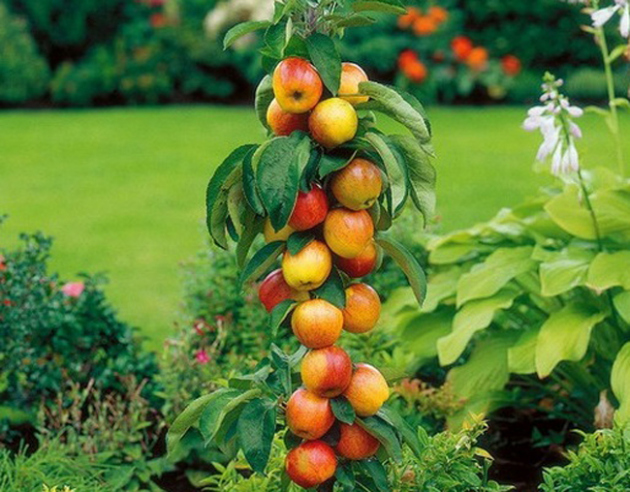
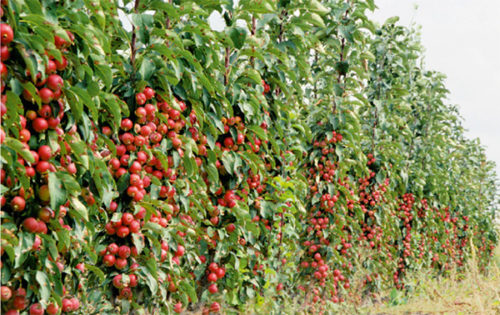
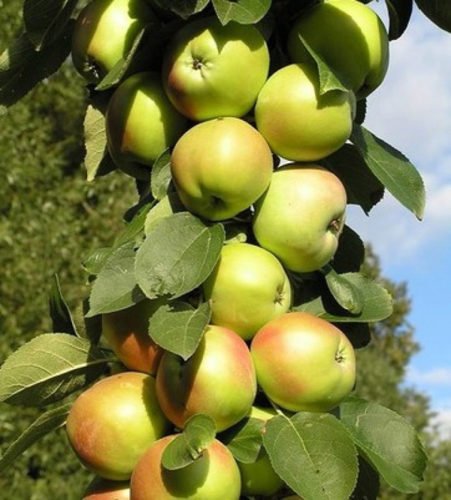

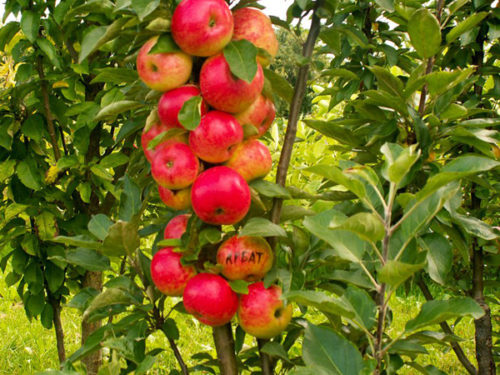
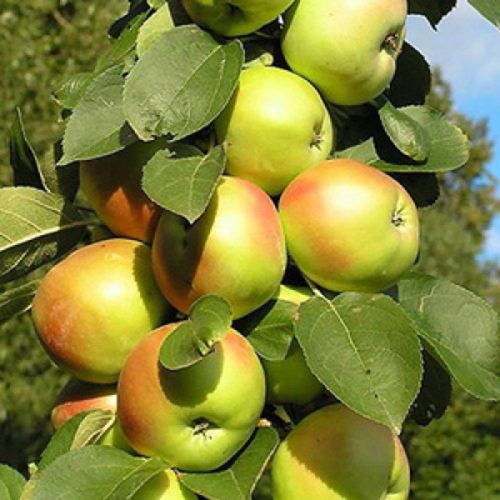
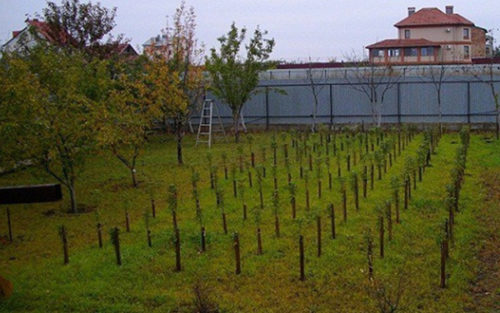
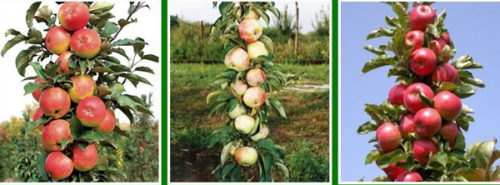
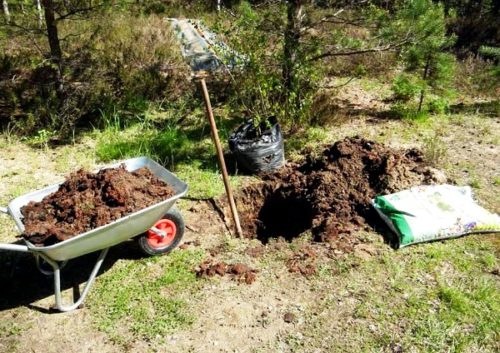
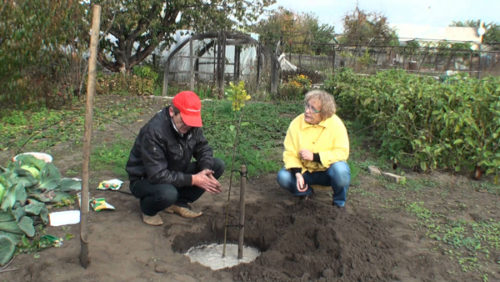
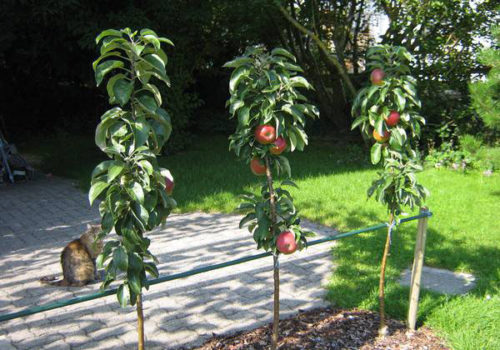
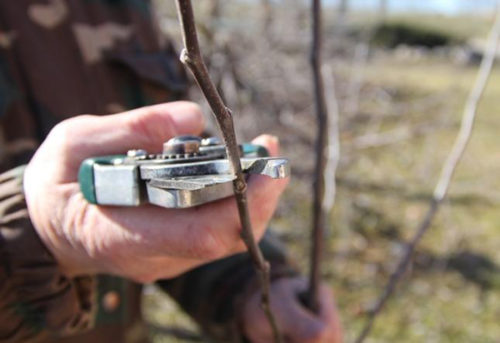
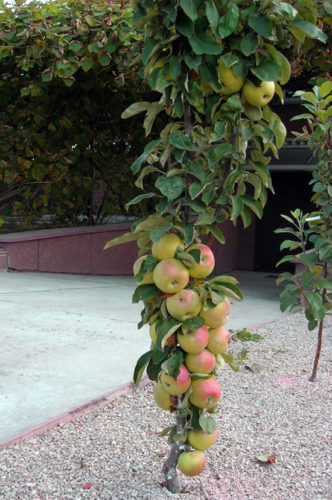
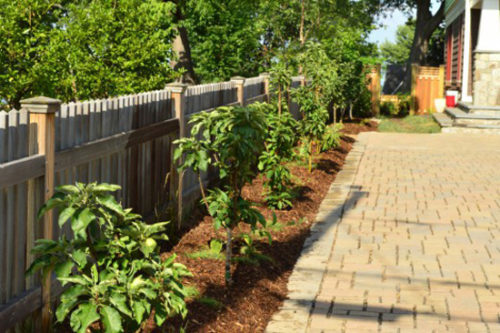
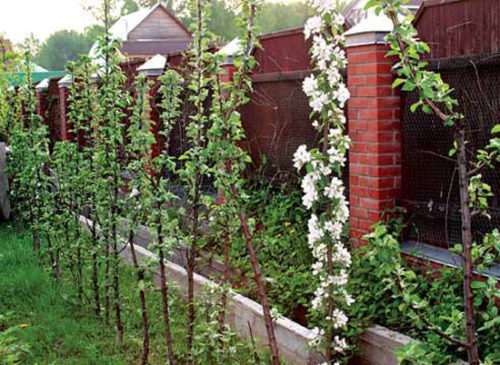
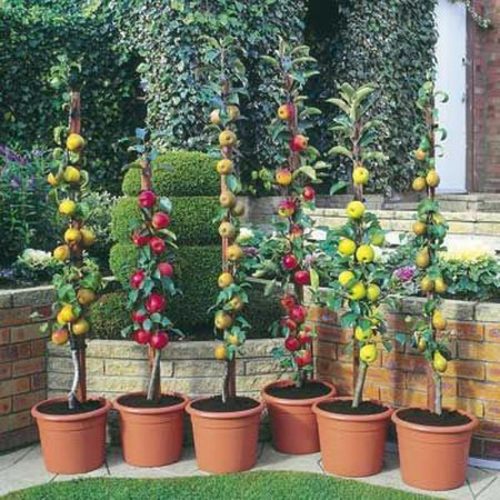












 Start a discussion ...
Start a discussion ...